My mouth is watering looking at that photo. ‘Tis the season of apples. This one’s not hard, although there are 4 steps to it: (1) caramel; (2) apples; (3) crunchy pecan and oat granola; and (4) whipped cream.
Having had this at a cooking class with Susan V a month or so ago, I knew I’d make it. So when my son and family decided to have a small family gathering, I offered to bring this. I could make everything ahead; all I had to do was heat up the caramel a little bit so it would pour (microwaved it) and layer the caramel, apples, granola and then add a bit of whipped cream on top.
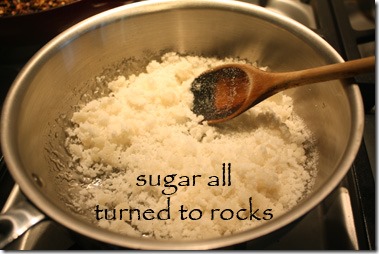 First I made the caramel – it was very easy and I made it in my really good (All-Clad copper core) saucier pan (not nonstick, and it’s not dark colored). The sugar (see photo at left) actually turns into sugar rocks – that’s what it’s supposed to do, so don’t think you’ve done something wrong. Once upon a time I did that (thought I’d bungled the sugar melting part and threw it out!) You need to be able to SEE the caramel as it develops, adding the heavy cream at the end (see next photo). This caramel sauce is really easy, however. I let it cool in the pan for about 5-10 minutes, then poured it into a glass jar and let it cool completely. Then I made the granola – rolled oats and pecans. They are pan-toasted (easy); just don’t let them burn. You want the granola
First I made the caramel – it was very easy and I made it in my really good (All-Clad copper core) saucier pan (not nonstick, and it’s not dark colored). The sugar (see photo at left) actually turns into sugar rocks – that’s what it’s supposed to do, so don’t think you’ve done something wrong. Once upon a time I did that (thought I’d bungled the sugar melting part and threw it out!) You need to be able to SEE the caramel as it develops, adding the heavy cream at the end (see next photo). This caramel sauce is really easy, however. I let it cool in the pan for about 5-10 minutes, then poured it into a glass jar and let it cool completely. Then I made the granola – rolled oats and pecans. They are pan-toasted (easy); just don’t let them burn. You want the granola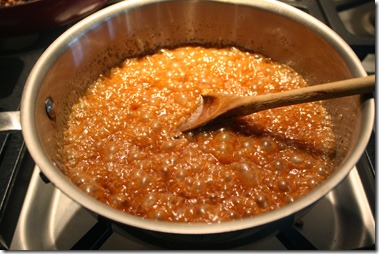 to be toasted but not blackened. Then you pour a melted butter and maple syrup mixture over the toasted granola and pour that out onto a plate to cool. Then I transferred that to a jar.
to be toasted but not blackened. Then you pour a melted butter and maple syrup mixture over the toasted granola and pour that out onto a plate to cool. Then I transferred that to a jar.
Then it’s the apples (photo below). Very easy. Peel and slice the apples (not too thin) then add them to a wide frying pan with melted butter and cinnamon. You stir them as they cook – you do want them to be nice and soft. Do use an apple variety that doesn’t fall apart – I used Honey Crisp. If you use Granny Smiths, you’ll likely need to add more maple syrup to make them sweet enough. 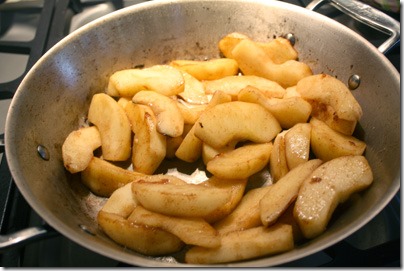 Using Honey Crisp doesn’t require much sweetening. Anyway, once the apples are cooked, add maple syrup to coat and you set them aside. I put them into a plastic container so I could transport them.
Using Honey Crisp doesn’t require much sweetening. Anyway, once the apples are cooked, add maple syrup to coat and you set them aside. I put them into a plastic container so I could transport them.
All I had to do then was whip some heavy cream (no added sugar as the dessert is plenty sweet) and added a tiny tetch of vanilla. It took all of about 5 minutes (with my grandson Vaughan right by my side, licking his chops and waiting for the whipped cream bowl) to put it all together.
At the cooking class, Susan raved about a new cookbook she’s just purchased (this recipe came from it) called Eat Delicious: 125 Recipes for Your Daily Dose of Awesome by Dennis Prescott. He’s made a name for himself mostly via Instagram and Twitter. He has jillions of followers. Some of his recipes are on his website: DennisThePrescott. He doesn’t write a blog – he just posts recipes. Since I don’t do much Instagram, and I don’t do Twitter, I’d not heard of him. Have you? . . . Anyway, Susan said she’d made several things from his new cookbook and said they were all really fabulous.
What’s GOOD: loved the combo of the salted caramel, the crunchy granola and the super delicious apples. This dessert is SO perfect for a fall dinner. The recipe says it serves 8-10 – I’m just mentioning that it doesn’t make really large portions. That was fine for this dinner, but you might want to increase the size of it if you know your family would want to devour it or you know you want leftovers!
What’s NOT: there are 4 steps to making this, but really, everything can be made ahead. All except the whipped cream, which could be made a few hours ahead.
printer-friendly PDF and MasterCook 15/16 file (click link to open recipe)
* Exported from MasterCook *
Salted Caramel Apple Parfaits
Recipe By: Eat Delicious by Dennis Prescott
Serving Size: 8
CARAMEL:
1 cup sugar
6 tablespoons unsalted butter
1/2 cup heavy cream
1/2 teaspoon vanilla extract
1 teaspoon sea salt
APPLES:
2 tablespoons butter
1 1/2 pounds apples — Honeycrisp, or other sweet crispy apples, peeled, cored, and cut into 1/2-inch chunks
1/2 teaspoon ground cinnamon
2 tablespoons pure maple syrup
GRANOLA:
1 1/2 cups rolled oats
1 cup pecan halves — chopped
1 tablespoon butter
2 tablespoons pure maple syrup
WHIPPED CREAM:
1 cup heavy cream
1/2 teaspoon pure vanilla extract
1. SALTED CARAMEL: In a high-sided nonstick pan, heat the sugar over medium heat, stirring continuously. It will turn into strange rock-ish pieces—that’s normal! See photo. Slowly but surely, the sugar will melt and turn into a gorgeous amber colour. When the sugar has melted entirely and is now golden brown in color, carefully stir in the butter and let it melt. It will bubble like crazy. Stirring continuously, slowly pour the cream into the pan in a slow and steady stream until it has been incorporated into the caramel. Let the mixture bubble away for 1 minute, then remove from the heat. Stir in the vanilla and sea salt and very carefully pour it into a medium heatproof bowl. Set aside.
2. APPLES: Heat a large skillet over medium heat and melt the butter. Add the apple chunks and cinnamon and cook, stirring often, for about 15 minutes, or until the apples are very soft. Add the maple syrup and give the pan a toss to coat the apples. Cook for 1 minute, then transfer to a bowl and set aside.
3. GRANOLA: Heat a large, dry skillet over medium heat and add the oats and pecans. Cook, turning every minute or so, until the oats are fragrant and have started to brown, 3 to 4 minutes. Transfer to a plate.
4. Place the pan back on the burner and melt the butter and maple syrup. When the syrup is simmering, remove from the heat and stir in the oats and pecans. Mix thoroughly to evenly coat the oats, then transfer to a plate and set aside.
5. WHIPPED CREAM: In the bowl of a stand mixer fitted with the whisk attachment (or whisk by hand or use a hand-held mixer), whip the cream until thick, then fold in the vanilla.
6. Build each parfait with about 2 tablespoons of the salted caramel, a scoop of the apples, and 2 tablespoons of the granola. Top with a dollop of whipped cream, then repeat. Finish with a final drizzle of caramel and serve.
Per Serving (assumes you’ll use all the caramel – you might not): 587 Calories; 40g Fat (59.0% calories from fat); 5g Protein; 58g Carbohydrate; 5g Dietary Fiber; 96mg Cholesterol; 299mg Sodium.





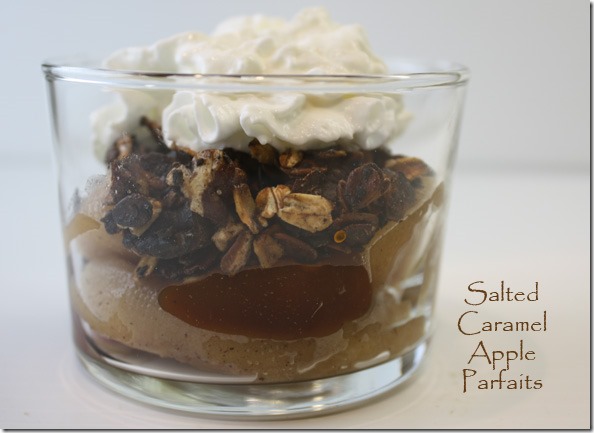



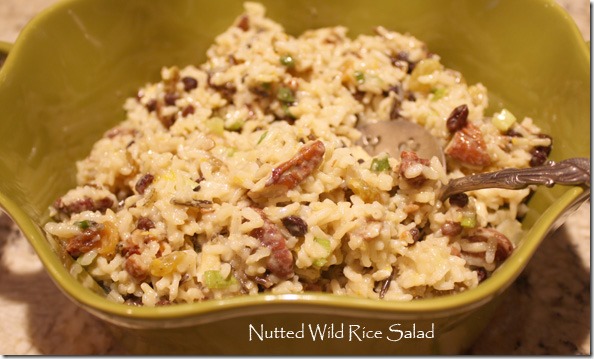
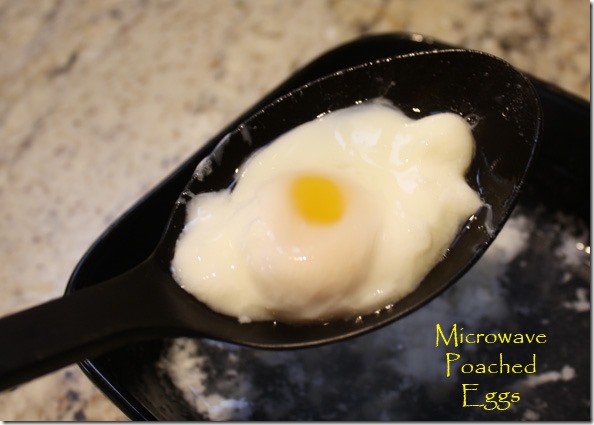
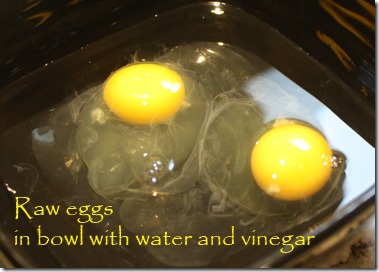
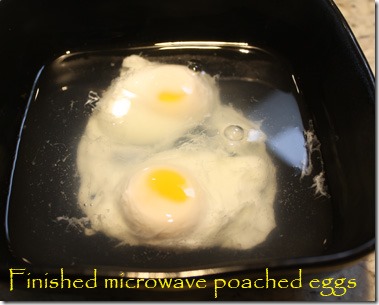
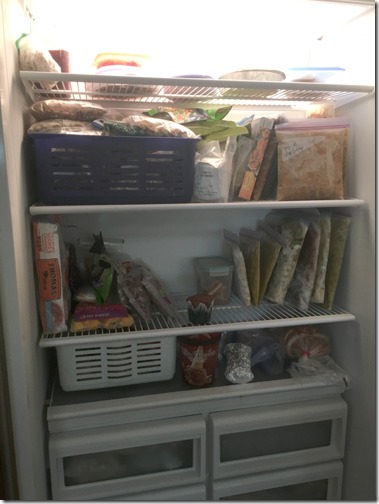

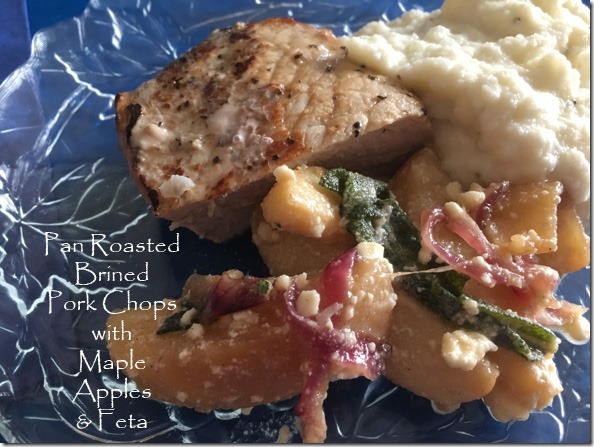
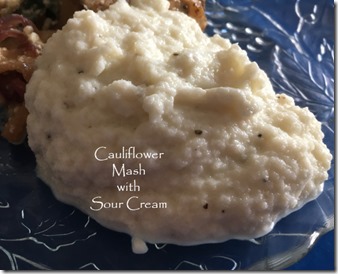
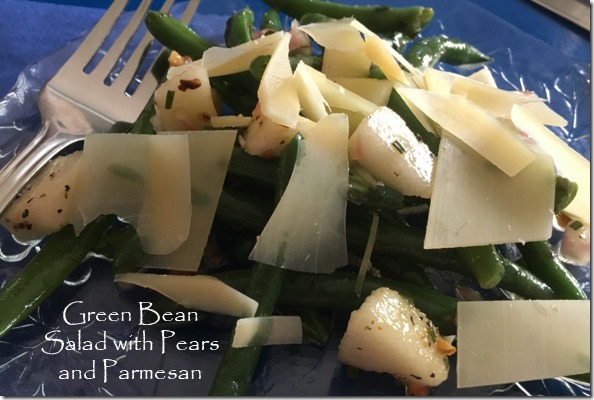
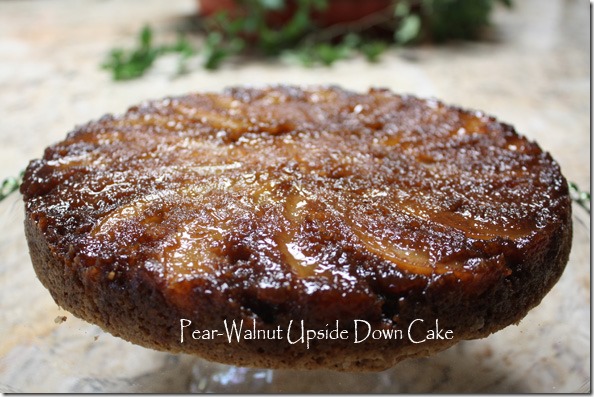
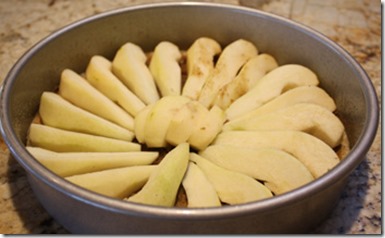
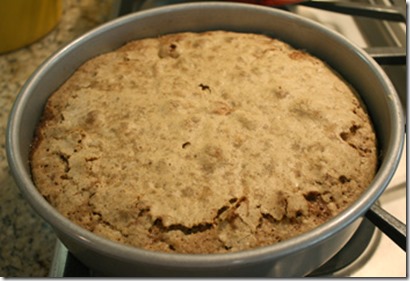





Leave a Comment!